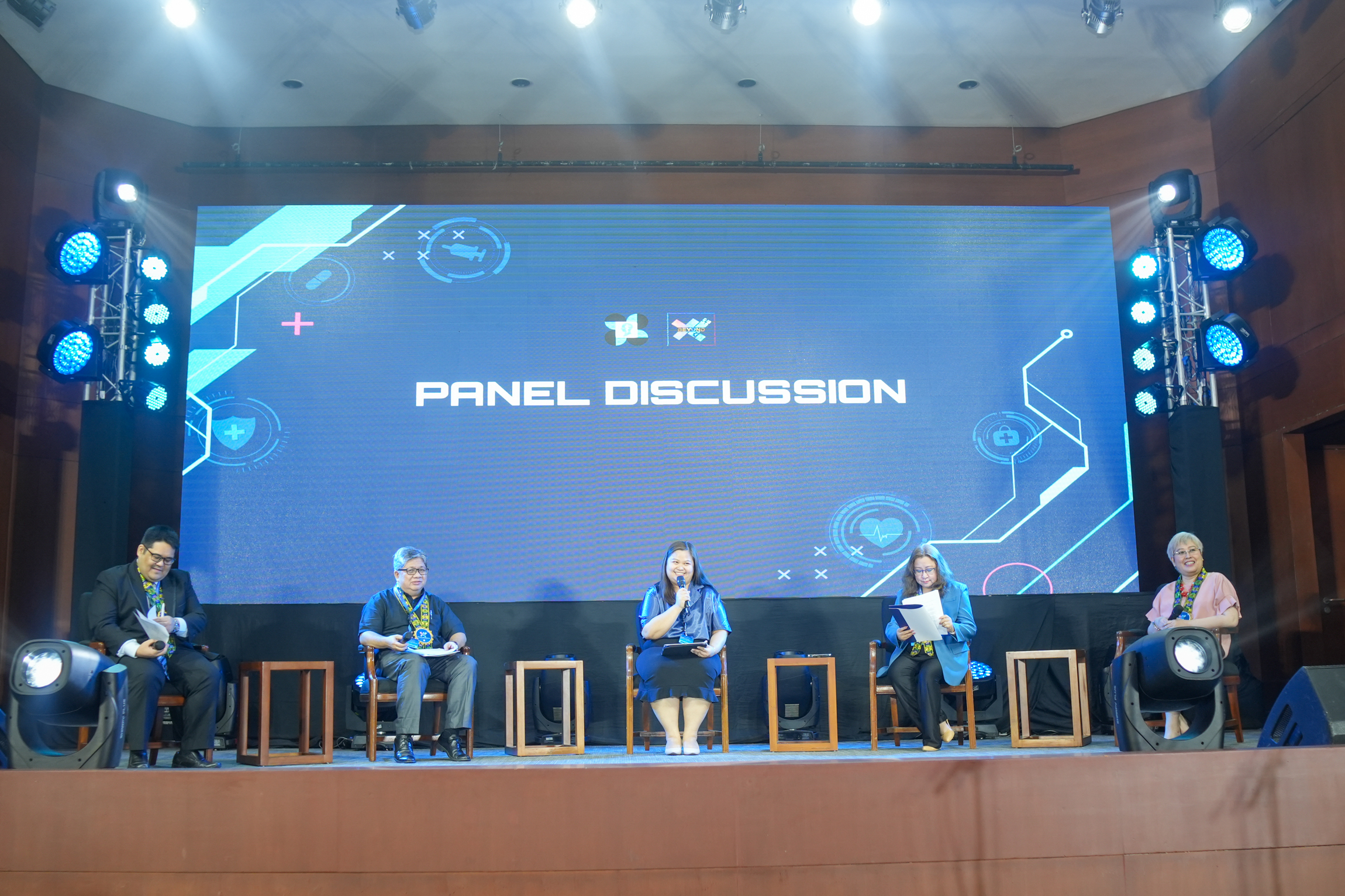NEWS AND UPDATES
What the future of digital healthcare would look like in the Philippines

What the future of digital healthcare would look like in the Philippines
Digital experts outline ways to achieve a robust digital healthcare system
“Digital healthcare transformation is not just about technology, it’s about new ways of thinking. It’s about innovation.”
In its 41st anniversary celebration, the Philippine Council for Health Research and Development hosted a discussion on digital healthcare transformation in the country with four Filipino digitalization experts on 17 March 2023 at Philippine International Convention Center (PICC), Pasay City.
Joining the plenary session are the Department of Information and Communication Technology (DICT) Undersecretary for ICT Industry, Usec. Jocelle Batapa-Sigue, University of the Philippines (UP) College of Medicine Professor, Dr. Iris Thiele Isip-Tan, Ateneo de Manila University (AdMU) Research Scientist Dr. Dennis Batangan, and Ateneo School of Medicine and Public Health Research Faculty Dr. Jeremie de Guzman. The discussion is facilitated by PCHRD’s Mental Health R&D S&T Fellow, Dr. Sarah Jane Jimenez.
Four topics revolving around the theme, “PCHRD Beyond XL: Transforming Healthcare Through Digitalization” were discussed, beginning with the preview of digitalization in the Philippines, opportunities and challenges, the role of R&D in digital health, and the future of digital healthcare in the country.
A preview of digitalization in the Philippines
Highlighting that the Philippines is ranked first in terms of consulting the internet for health symptoms, Usec. Batapa-Sigue mentions that the average Filipino spends 10 hours on the internet, which is four hours higher than the six hours average globally.
“Right now, we have 77% of our country covered with internet connectivity, but 85% of our population is on the internet,” says Usec. Batapa-Sigue. “Meaning, we at the DICT have to make sure to close that gap, where the remaining 23% who are mostly in the geographically isolated and disadvantaged areas (GIDA) where healthcare solutions are much needed are reached,” Usec.Batapa-Sigue added.
Looking back to the beginning of digital healthcare initiatives from the University of the Philippines Manila side, Dr. Isip-Tan stated that the establishment of the National Telehealth Center around 1998 paved the way for the development of two of the first digital health innovations in the country: the Community Health Information Tracking System (CHITS) in 2004 and the RxBox in 2007.
Road to digital transformation: Opportunities and challenges
Contrary to the belief that digital transformation will destroy jobs, Usec. Batapa-Sigue states, that digitalization “will also create several times more than the jobs that it will destroy across all sectors.” In healthcare, Usec. Batapa-Sigue adds that the DICT is looking at a total of almost 300,000 jobs by 2028, and about Php 6.7 million in revenue in the next five or six years.
Dr. Isip-Tan, citing the Digital Health Index of the Philippines, shares that in terms of the workforce, there is a need to integrate digital health into the health professions curriculum so that a wide range of jobs will be created and opportunities will widen.
On the other hand, Dr. Isip-Tan states that there are still challenges that need to be addressed to maximize digital healthcare opportunities. Citing the challenges encountered by the Philippine General Hospital (PGH) during the height of the pandemic, Dr. Isip-Tan recalls, “For telemedicine, we were always told that we have limited bandwidth. During the pandemic, the PGH was still able to provide services using mobile phones because our patients didn’t have Wi-Fi.” Despite this, Dr. Isip-Tan believed that the lessons learned about teleconsultations “will be able to improve the healthcare system.”
“I think one of the challenges is how to converge the national government and local government so that we will be able to respond to the needs of our citizens,” Dr. Batangan, focusing on Universal Health Care (UHC), adds, citing that along with digitalization is the need to understand the governance aspects.
A critical factor in digitalizing healthcare solutions is the Philippine ID, as Dr. Batangan explains that the Philippine ID becomes one’s eligibility as a citizen to avail of all the services that one wants to access. “Eventually, it will define to a certain extent, the digital innovations or digital systems that we are developing,” he said.
The huge role of R&D in transforming healthcare through digitalization
According to Dr. de Guzman, there are multiple layers of R&D for digital health, including policies, services, and interventions. “R&D has to be focused on these areas and it has to be done well: How well does it work? To whom does it work and why does it work? How much is it and who pays for it?” he said. Dr. de Guzman adds that these tools should be integrated into the standards of care, as these will help improve the quality of care, the convenience of care, and the responsiveness to each and every Filipino.
Across the spectrum of R&D from conception, initial proof of concept, down to clinical studies, Dr. de Guzman stressed the importance of understanding the life cycle of the technology and providing the evidence for its use to help in its adoption. “When we develop a technology, it has to be fit for purpose, it has to be the kind that we need,” Dr. de Guzman explains. “And that’s where the PCHRD comes in, where you can see these ideas and actually turn them into real products and services and make sure they reach the patient or the Filipino.” he furthered.
Hearing Dr. de Guzman’s discussion on digital health R&D, Usec. Batapa-Sigue believes that connectivity is not enough, stating that “where connectivity is flowing in this country, there has to be digital skills, digital solutions, and digital champions; it has to be a whole ecosystem.”
What the future digital healthcare would look like in the Philippines
“The future of digital healthcare is multidisciplinary,” Dr. Isip-Tan stated, adding that fighting an infodemic involves professionals in various disciplines. “Everything, the services and the systems, will have to depend on digitalization,” Dr. Batangan on summarizing his discussion said. “I think the convergence point, in the future of e-health, would be local government units and the Philippine ID system,” he adds.
For Dr. de Guzman, there are three aspects in looking at the future of digital healthcare in the country. “First is clarity on the process of how do we get the products, to patients. Second is harnessing our existing capacity, because there are lots of great researchers here. And third is making sure that our solutions are fit for our context. You have to make solutions that answer our problems,” he explains.
In envisioning the future of digital healthcare, Dr. Batapa-Sigue shares three factors: internet, innovation, and inclusion. “Let’s include the women, the Persons with Disabilities, the senior citizens. I’m actually very much excited about where we are at now in terms of digitalizing the healthcare system because of the advent of a lot of technologies, which makes it really easy for us to design applications and systems,” she adds.
“And lastly, this is the starting point of making a new segment of the economy, where we take our own destiny, where we say we have to be able to make the solutions that work for us to be able to support the lifetime of each and every Filipino, which have to be implemented with a very good backbone of R&D translation,” Dr. de Guzman added.
The PCHRD’s 41st anniversary celebration was attended by over 340 stakeholders in health from the government and private sector, researchers, experts, and the industry. A replay of the plenary session may be viewed through this link.




